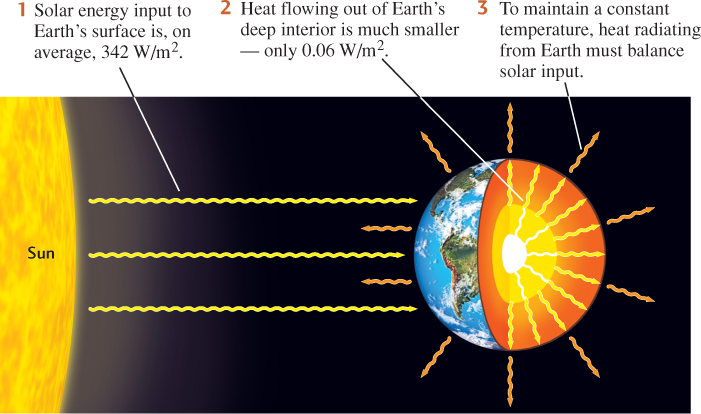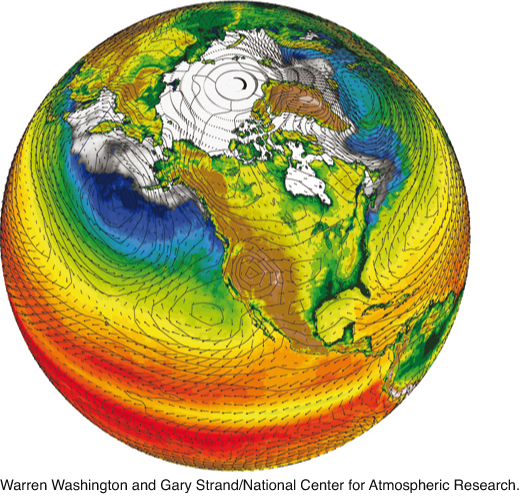The Greenhouse Effect
The Sun is a yellow star that emits about half its radiant energy as visible light. The other half is split between infrared waves, which have longer wavelengths and lower energy intensities than visible light (and which we perceive as heat), and ultraviolet waves, which have shorter wavelengths and higher energy intensities than visible light. The average amount of solar radiation Earth’s surface receives throughout the year is 340 watts per square meter of surface area (340 W/m2; 1 watt = 1 joule per second, and joule is a unit of energy or heat). In comparison, the average amount of heat flowing out of Earth’s deep interior by mantle convection is minuscule, only 0.06 W/m2. Essentially all the energy driving the climate system ultimately comes from the Sun (Figure 15.6).

We know that the global surface temperature, averaged over daily and seasonal cycles, remains constant. Therefore, Earth’s surface must be radiating energy back into space at a rate of precisely 340 W/m2. Any less would cause the surface to heat up; any more would cause it to cool down. In other words, Earth maintains a radiation balance: an equilibrium between incoming and outgoing radiant energy. How is this equilibrium achieved?
A Planet Without Greenhouse Gases
Suppose Earth were a rocky sphere like the Moon, with no atmosphere at all. Some of the sunlight falling on the surface would be reflected back into space, and some would be absorbed by the rocks, depending on the color of the surface. A perfectly white planet would reflect all the solar energy falling on it, whereas a perfectly black planet would absorb it all. The fraction of the solar energy reflected by a surface is called its albedo (from the Latin word albus, meaning “white”). Although the full Moon looks bright to us, the rocks on its surface are mainly dark basalts, so its albedo is only about 7 percent. In other words, the Moon is dark gray—very nearly black.
The energy radiated by a black body increases rapidly as its temperature increases. A cold bar of iron is black and gives off little heat. If you heat the bar to 100°C, it gives off warmth in the form of infrared radiation (like a steam radiator). If you heat the bar to 1000°C, it becomes bright orange, radiating heat at visible wavelengths (like the burner on an electric stove).
A black body exposed to the Sun heats up until its temperature is at just the right value for it to radiate the incoming solar energy back into space. The same principle applies to a “gray body” like the Moon, except that the reflected energy must be excluded from the radiation balance. And, in the case of rotating bodies like the Moon and Earth, day-and-night cycles must be taken into account. The Moon’s daytime temperatures rise to 130°C, and its nighttime temperatures drop to −170°C. Not a pleasant environment!
Earth rotates much faster than the Moon (once per day rather than once per month), which evens out the day-and-night extremes of temperature. Earth’s albedo, at about 29 percent, is much higher than the Moon’s because Earth’s blue oceans, white clouds, and ice caps are more reflective than dark lunar basalts. If our atmosphere did not contain greenhouse gases, the average surface temperature required to balance the absorbed solar radiation would be about −19°C (−28F), cold enough to freeze all the water on the planet. Instead, Earth’s average surface temperature remains a balmy 14°C (578F). The difference of 33°C is a result of the greenhouse effect.
414
Earth’s Greenhouse Atmosphere
Greenhouse gases, such as water vapor, carbon dioxide, methane, and ozone, absorb energy—coming directly from the Sun as well as radiated by Earth’s surface—and reradiate it as infrared energy in all directions, including downward to the surface. In this way, they act like the glass in a greenhouse, allowing light energy to pass through, but trapping heat in the atmosphere. This trapping of heat, which increases the temperature at the surface relative to the temperature higher in the atmosphere, is known as the greenhouse effect.
How Earth’s atmosphere balances incoming and outgoing radiation is illustrated in Figure 15.7. Incoming solar radiation that is not directly reflected is absorbed by Earth’s atmosphere and surface. To achieve radiation balance, Earth radiates this same amount of energy back into space as infrared energy. Because of the heat trapped by greenhouse gases, the amount of energy transported away from Earth’s surface, both by radiation and by the flow of warm air and moisture from the surface, is significantly larger than the amount Earth receives as direct solar radiation. The excess is exactly the energy received as Earthward infrared radiation from the greenhouse gases. It is this “back radiation” that causes Earth’s surface to be 33°C warmer than it would be if the atmosphere contained no greenhouse gases.

Balancing the Climate System Through Feedbacks
How does the climate system actually achieve the radiation balance illustrated in Figure 15.7? Why does the greenhouse effect yield an overall warming of 33°C and not some larger or smaller amount? The answers to these questions are not simple because they depend on interactions among the many components of the climate system. The most important of those interactions involve feedbacks.
415
Feedbacks come in two basic types: positive feedbacks, in which a change in one component is enhanced by the changes it induces in other components, and negative feedbacks, in which a change in one component is reduced by the changes it induces in other components. Positive feedbacks tend to amplify changes in a system, whereas negative feedbacks tend to stabilize the system against change.
Here are some of the feedbacks within the climate system that affect the surface temperature achieved by radiation balance:
 Water vapor feedback. A rise in temperature increases the amount of water vapor that moves from Earth’s surface into the atmosphere through evaporation. Water vapor is a greenhouse gas, so this increase enhances the greenhouse effect, and the temperature rises further—a positive feedback.
Water vapor feedback. A rise in temperature increases the amount of water vapor that moves from Earth’s surface into the atmosphere through evaporation. Water vapor is a greenhouse gas, so this increase enhances the greenhouse effect, and the temperature rises further—a positive feedback. Albedo feedback. A rise in temperature reduces the accumulation of ice and snow in the cryosphere, which decreases Earth’s albedo and increases the energy its surface absorbs. This increased warming enhances the temperature rise—another positive feedback.
Albedo feedback. A rise in temperature reduces the accumulation of ice and snow in the cryosphere, which decreases Earth’s albedo and increases the energy its surface absorbs. This increased warming enhances the temperature rise—another positive feedback. Radiative damping. A rise in atmospheric temperature increases the amount of infrared energy radiated back into space, which moderates the temperature rise—a negative feedback. This “radiative damping” stabilizes Earth’s climate against major temperature changes, keeping the oceans from freezing up or boiling off and thus maintaining an equable habitat for water-loving life.
Radiative damping. A rise in atmospheric temperature increases the amount of infrared energy radiated back into space, which moderates the temperature rise—a negative feedback. This “radiative damping” stabilizes Earth’s climate against major temperature changes, keeping the oceans from freezing up or boiling off and thus maintaining an equable habitat for water-loving life. Plant growth feedback. Increasing atmospheric CO2 concentrations stimulate plant growth. Growing plants remove CO2 from the atmosphere by converting it into carbon-rich organic matter, thus reducing the greenhouse effect—another negative feedback.
Plant growth feedback. Increasing atmospheric CO2 concentrations stimulate plant growth. Growing plants remove CO2 from the atmosphere by converting it into carbon-rich organic matter, thus reducing the greenhouse effect—another negative feedback.
Feedbacks can involve much more complex interactions among components of the climate system. For example, an increase in atmospheric water vapor produces more clouds. Because clouds reflect solar energy, they increase the planetary albedo, which sets up a negative feedback between atmospheric water vapor and temperature. On the other hand, clouds absorb infrared radiation efficiently, so increasing the cloud cover enhances the greenhouse effect, thus providing a positive feedback between atmospheric water vapor and temperature. Does the net effect of clouds produce a positive or a negative feedback?
Scientists have found it surprisingly difficult to answer such questions. The components of our climate system are joined through an amazingly complex web of interactions on a scale far beyond experimental control. Consequently, it is often impossible to gather data that isolate one type of feedback from all the others. Scientists must therefore turn to computer models to understand the inner workings of the climate system.
Climate Models and Their Limitations
Generally speaking, a climate model is any representation of the climate system that can reproduce one or more aspects of its behavior. Some models are designed to study local or regional climate processes, such as the relationships between water vapor and clouds, but the most interesting representations are global models that describe how climate has changed in the past or predict how it might change in the future.
At the heart of such global climate models are schemes for computing movements within the atmosphere and oceans based on the fundamental laws of physics. These general circulation models represent the currents of air and water driven by solar energy on scales ranging from small disturbances (storms in the atmosphere, eddies in the oceans) to global circulation patterns (wind belts in the atmosphere, thermohaline circulation in the oceans). Scientists represent the basic physical variables (temperature, pressure, density, velocity, and so forth) on three-dimensional grids comprising millions, or even billions, of geographic points. They use supercomputers to solve mathematical equations that describe how the variables change over time at each of these points (Figure 15.8). You see the results of these calculations whenever you tune in the weather report on your favorite TV station. These days, most weather predictions are made by entering the current conditions observed at thousands of weather stations into a general circulation model and running it forward in time. Weather predictions thus use the same basic computer programs that are used for climate modeling.

416
Climate modeling is more difficult than weather prediction, however. In predicting weather a few days from now, scientists can ignore such slow processes as changes in atmospheric greenhouse gas concentrations or in oceanic circulation. Climate predictions, on the other hand, require that we properly model these slow processes, including all important feedbacks, in addition to the rapid movements of air masses. Moreover, the simulation must be extended years or decades into the future. Such enormous calculations require weeks of time on the world’s largest supercomputers.
Because current climate models are complex and subject to error, their predictions must be viewed with some skepticism. Many questions remain about how the climate system works—for instance, how clouds affect atmospheric temperatures. The predictions of climate models have been a topic of much debate among experts and government authorities who must understand and deal with the consequences of human-induced climate change. We will take a closer look at those predictions in Chapter 23.